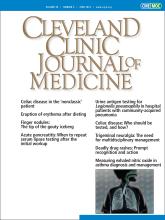A 28-year-old man presented to the dermatology clinic with a 1-week history of edematous erythema on his chest and neck. He complained of mild itching. He had received treatment with oral levocetirizine and topical 0.05% halometasone cream for 5 days, but the rash did not improve and actually worsened. He said that over the past 4 weeks he had been increasing his exercise and was on a strict diet for bodybuilding.
He had no significant past medical history and no history of drug or food allergies. Physical examination showed reticulate erythema with hyperpigmentation on the chest and neck (Figure 1), as well as the back. Laboratory testing revealed a high urinary ketone level of 2+ (reference range negative). The complete blood cell count, hepatic and renal function, fasting plasma glucose, glycosylated hemoglobin, blood lipid, and fungal microscopy examination were normal. We diagnosed prurigo pigmentosa based on the clinical presentation and results of laboratory testing.
Reticulate erythema with hyperpigmentation on the chest and neck, as well as on the back.
PRURIGO PIGMENTOSA
Prurigo pigmentosa is an inflammatory dermatosis that usually occurs in young Asians and has a pronounced female predominance.1 It is characterized by pruritic erythematous papules with a reticulate pattern on the back, chest, and neck, leaving behind hyperpigmentation after several days to weeks from the time of onset. The hyperpigmentation usually persists for several months.
Ketone bodies may play a key role in the pathogenesis. The proketogenic state results in an accumulation of ketone bodies around blood vessels that can further lead to dermal perivascular inflammation and contribute to the development of the condition.1,2
The most common risk factor is a change in diet including low-carbohydrate and ketogenic diets and anorexia nervosa.1 Other potential triggers include friction from clothing,3 sweat, ketonuria, hormonal changes, emotional stress, nutritional deficiency, atopic dermatitis, diabetes mellitus, adult-onset Still disease, acupuncture, pregnancy, and Helicobacter pylori infection.1,2 As the ketogenic diet and dieting become increasingly popular, cases of prurigo pigmentosa seem to be on the rise4 and may be underdiagnosed due to poor recognition.
Differential diagnosis
The diagnosis of prurigo pigmentosa is primarily clinical. Biopsy is performed when the clinical presentation is atypical or the diagnosis is in doubt.
The differential diagnosis includes confluent and reticulated papillomatosis, seborrheic dermatitis, contact dermatitis, eczema, dermatitis herpetiformis, psoriasis vulgaris, systemic lupus erythematosus, urticaria, and erythema multiforme. Confluent and reticulated papillomatosis is generally considered to only present reticulated hyperpigmentation without obvious inflammation and pruritus. However, it has been described along with pruritic inflammatory rash, and there is an opinion that confluent and reticulated papillomatosis and prurigo pigmentosa are different manifestations of the same disease spectrum because they have similar clinical and histologic findings and respond to similar therapies.5
Therapy
Commonly, antihistamines and topical corticosteroids are ineffective for prurigo pigmentosa. The first-line treatment includes antibiotics such as minocycline, doxycycline, and dapsone.1 Resuming a balanced diet can be useful to patients with ketosis or nutritional deficiencies.1 A minority of patients experience a recurrence. Our patient was advised to resume a normal diet and was treated with oral doxycycline and topical tacrolimus for 2 weeks. The rash gradually resolved, leaving reticular hyperpigmentation.
DISCLOSURES
The authors report no relevant financial relationships which, in the context of their contributions, could be perceived as a potential conflict of interest.
- Copyright © 2023 The Cleveland Clinic Foundation. All Rights Reserved.







